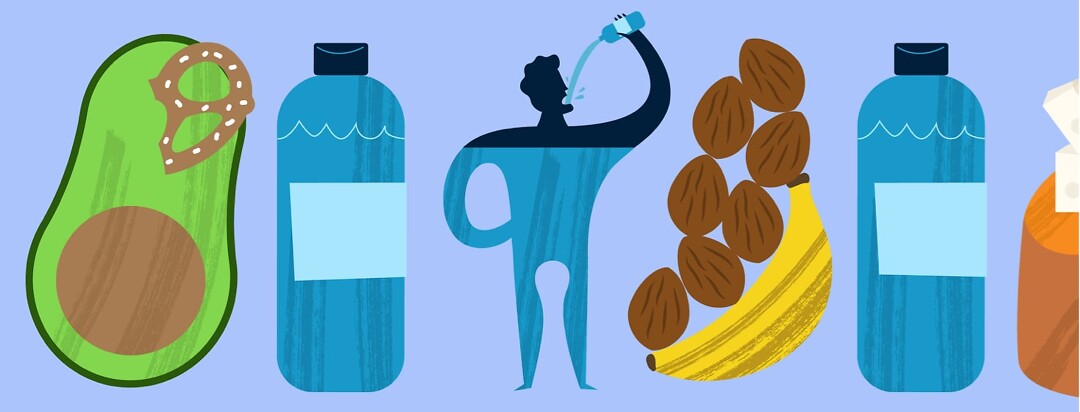Hydration, Electrolytes, and Beating the Heat With Type 2 Diabetes
Being hydrated seems to be the solution to many concerns. Clear skin, proper digestion, body temperature regulation, and more. But, did you know that adequate hydration can also contribute to blood sugar control? It’s easy to lose track of your fluid status when spending the day barbecuing, poolside with the family, enjoying your favorite outdoor activity, or working in the heat. While proper diabetes management requires extra focus on maintaining adequate hydration, it can be made easy with these helpful tips.
How does hydration affect blood sugar?
On a hot summer’s day, just about any activity can cause you to break a sweat. But what you may not realize is you may push yourself harder on those cooler days, exerting yourself more taking on more physically challenging projects or longer walks. The combination of sweat and low fluid intake can quickly lead to inadequate hydration. With excessive fluid loss comes an increase in blood sugar concentration, leading to frequent trips to the bathroom, furthering fluid losses.
For people with type 2 diabetes, this can ultimately increase one’s risk of hyperglycemia.1 To improve fluid retention, remember to hydrate with water consistently throughout the day. If you are sweating buckets during your workout or outdoor chores, you may want to consider incorporating a low-carbohydrate electrolyte beverage for complete hydration. As a first step, experiment with half a no-sugar-added hydration tablet or a stevia-sweetened sports drink!
Heat, electrolytes, and type 2 diabetes 101
Electrolytes can be tricky. I’ve worked with clients who feel depleted after a long workout even in cooler weather, and with proper carbohydrate fueling. In some cases, replenishing electrolytes can help prevent post-exercise fatigue. But usually, this is only after either strenuous workouts, long walks or hikes, or under harsh environmental conditions—like extensive yard work in the heat. I see this more often, with outdoor landscaping or DYI (do-it-yourself) outdoor projects.
When people sweat, they lose critical nutrients such as sodium, potassium, chloride, and other trace minerals. Electrolytes are essential for fluid balance, which allows the body to rehydrate effectively.2 After a prolonged sweat in the heat or a lengthy workout (60-90 minutes), water alone simply won’t cut it. Avoid issues such as heat exhaustion or heat stroke by ensuring adequate fluid and electrolyte intake. Remember to take breaks and pace yourself, especially when working on strenuous projects that require continuous movement.
Electrolyte tablets and electrolyte snacks
If hydration tablets without added sugar or zero-calorie sugar-substitute sports drinks aren’t for you, give these whole food electrolyte-boosting snacks a try! Just remember to work them into your existing meal plan.
- 1 cup of 100% coconut water with a pinch of salt
- ½ avocado with 1 oz of whole-grain pretzels or the trendy cauliflower or butternut squash pretzels
- ½ small sweet potato with 1 oz low-fat cheese
- 1 small banana and 1 oz salted nuts
- 1 cup of tomato juice beverage
- 1 cup of diced cantaloupe with a pinch of salt
When should electrolytes be utilized?
While you may or may not consider yourself an exercise enthusiast, electrolytes are still necessary for long workouts, strenuous yard work, or prolonged time in extreme heat and humidity. These can come from food first or when indicated, a sugar-free electrolyte substitute. Have you taken on more DIY improvement projects lately or enjoyed long walks in the heat? If so, electrolytes may be needed! Under these challenging environmental conditions, the body cannot cool itself adequately, resulting in a loss of both electrolytes and fluid. Not to mention, the intense physical demands of a long day golfing or outdoor home repairs can cause a negative fluid balance.
Also, if you sweat heavily, you may be more prone to electrolyte depletion. A good way to tell is if you get a yellow rim around your hat, sweat stains in your shirt's armpit area, or notice your lips tasting salty. As a solution, you could try a sugar-free electrolyte beverage or an electrolyte repletion snack to replenish nutrients lost through sweat, and aid with water retention to minimize fluid loss.
See How to Spot Signs of Dehydration, part two of this article, to understand how to recognize the signs of dehydration and easy ways to stay hydrated and choose electrolytes.

Join the conversation